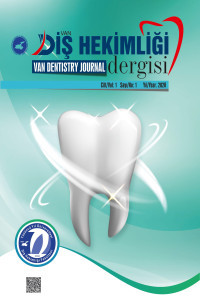Splintlemede Kullanılan Materyaller Ve Splint Tipleri
Mobilite, periodontal splint, splint materyalleri
Materials Used in Splinting and Splint Types
Mobility, periodontal splint, splint materials,
___
- 1. Kwon S-O. Philosophical background of evidence-based medicine. Uisahak. 2004;13(2):335-46.
- 2. Rosenberg W, Donald A. Evidence based medicine: an approach to clinical problem-solving. BMJ. 1995;310(6987):1122-6.
- 3. Vig KWL. Evidence-Based Orthodontics – Its Evolution and Clinical Application. Evidence-Based Orthodontics. John Wiley & Sons, Ltd; 2018: 1-9.
- 4. Evidence-Based Medicine Working Group. Evidence-based medicine. A new approach to teaching the practice of medicine. Jama. 1992;268(17):2420-5.
- 5. McNamara JA, Ribbens KA. Early orthodontic treatment: is the benefit worth the burden? Department of Orthodontics and Pediatric Dentistry. Ann Arbor, Mich: 2007.
- 6. O’Brien K, Macfarlane T, Wright J, Conboy F, Appelbe P, Birnie D et al. Early treatment for Class II malocclusion and perceived improvements in facial profile. Am J Orthod Dentofacial Orthop. 2009;135(5):580-5.
- 7. Papageorgiou SN, Eliades T. Evidence-based orthodontics: Too many systematic reviews, too few trials. J Orthod. 2019;46(1):9-12.
- 8. Rinchuse DJ, Sweitzer EM, Rinchuse DJ, Rinchuse DL. Understanding science and evidence-based decision making in orthodontics. American Journal of Orthodontics and Dentofacial Orthopedics. 2005;127(5):618-24.
- 9. Genç S, Soysal MI? Parametrik ve Parametrik Olmayan Çoklu Karşılaştırma Testleri. Black Sea Journal of Engineering and Science. 2018;1(1):18-27.
- 10. Akram NC, Harrison JE. Evidence-based orthodontics Structured Abstracts. Journal of Orthodontics. 2008;35(4):276-82.
- 11. Glenny A-M, Harrison JE. How to...interpret the orthodontic literature. J Orthod. 2003;30(2):159-64.
- 12. JONES C. Evidence-based medicine: Research methods. Pharmaceutical journal. 2002;268(7202):839-41.
- 13. Levin KA. Study design III: Cross-sectional studies. Evid Based Dent. 2006;7(1):24-5.
- 14. Green BN, Johnson CD. How to write a case report for publication. Journal of Chiropractic Medicine. 2006;5(2):72-82.
- 15. Yılmaz E. Yarbay M. Kanıta Dayalı Tıp. J Clin Anal Med. 2014;5(6):537-542.
- 16. Akin B, Koçoğlu D. Randomize Kontrollü Deneyler. Hacettepe Üniversitesi Hemşirelik Fakültesi Dergisi. 2017;4(1):73-92.
- 17. Krishnan V, Davidovitch Z. On a path to unfolding the biological mechanisms of orthodontic tooth movement. J Dent Res. 2009;88(7):597-608.
- 18. Bartel DP. Metazoan MicroRNAs. Cell. 2018;173(1):20-51.
- 19. Yang L, Cheng P, Chen C, He H-B, Xie G-Q, Zhou H-D, vd. Function loop mediates osteoblast mineralization. J Bone Miner Res. 2012;27(7):1598-606.
- 20. Glass GV. Primary, Secondary, and Meta-Analysis of Research. Educational Researcher. 1976;5(10):3-8.
- 21. Topçu P. Cinsiyetin bilgisayar tutumu üzerindeki etkisi: bir meta analiz çalışması. Yüksek Lisans Tezi, İstanbul: Marmara Üniversitesi, 2009.
- 22. Comparative Education: Vol 57, No 3 [İnternet]. [2021]. Erişim adresi: https://www.tandfonline.com/toc/cced20/current?gclid=CjwKCAjwuvmHBhAxEiwAWAYj-IwhE45aX5Pwuuj4UeX953TYdW6qz9gbtKU7UW_L1kfBWwXaLIAjkBoCYGEQAvD_BwE
- 23. Tavşancil E, Kinay E. Üniversite giriş sınavı yordama geçerliği çalışmalarının meta analizi. Tez, Ankara: Üniversitesi Eğitim Bilimleri Enstitüsü Ve Değerlendirme Anabilim Dalı; 2012.
- 24. Kunin CM. Antibiotic Resistance—A World Health Problem We Cannot Ignore. Ann Intern Med. 1979;99(6):859-60.
- Başlangıç: 2020
- Yayıncı: Van Yüzüncü Yıl Üniversitesi
Basem ALSHUJAA, Dicle ALTINDAL, Ahmet Cemil TALMAÇ, Mohammad ALNASRALLAH
Sınıf I Maloklüzyona Sahip Bireyin Şeffaf Plak ile Ortodontik Tedavisi: Vaka Raporu
Ahmet Can YILMAZ, Yasemin TUNCA, Seda KOTAN, Nihal FAHRZADEH
Mukogingival Cerrahi Tedavi Uygulanacak Hastalarda Farkındalığın Dental Anksiyete Düzeyine Etkisi
Kübra ESKİN, Büşra Sümeyye KAVUT, Elif Töre SARİ, Yasemin Beliz ÖNDER, Nazlı Zeynep ALPASLAN
Splintlemede Kullanılan Materyaller Ve Splint Tipleri
Anas ALSAFADI, Basem ALSHUJAA, Dicle ALTINDAL
Fırçalamanın Zamana Bağlı CAD/CAM Materyallerinin Pürüzlülüğüne Etkisi
Özgür Ozan TANRIKUT, Büşra Sümeyye KAVUT, İdris KAVUT
Kemikiçi Defektin Trombositten Zengin Fibrin ile Tedavisi: 2 Yıllık Takip Vaka Raporu
Mohammed F.a ALKHATIB, Hacer ŞAHİN AYDINYURT, Nasser SHOSHAA
Volkan KAPLAN, Levent CİĞERİM, Mehmet GÜZEL, Jamil BAYZED, Hayrettin BAŞ, Hüseyin Melik BÖYÜK
